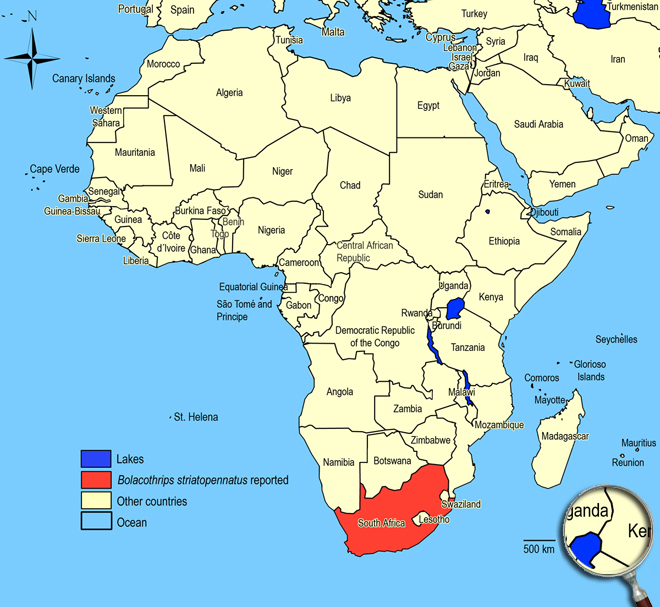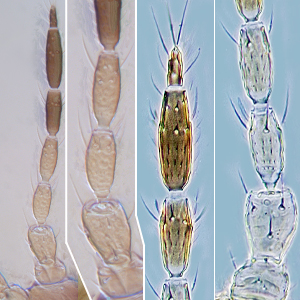Bolacothrips striatopennatus (Schmutz, 1913)
Thripinae, Thripidae, Terebrantia, Thysanoptera
Figures
Fig. 1: 7-segmented antenna, segments I-IV, and terminal segments V-VII
Fig. 2: Head dorsal with ocellar triangle
Fig. 3: Pronotum
Fig. 4: Meso- and metanotum
Fig. 5: Metanotum craniale
Fig. 6: Fore wing, distal area of fore wing
Fig. 7: Sternites VI and VII
Fig. 8: Sternites VI and VII
Fig. 9: Tergites VII and VIII with ctenidia
Fig. 10: Tergites VIII and IX
Introduction and recognition
Bolacothrips striatopennatus is a grass feeding thrips. Female macropterous or micropterous with fore wings about as long as thorax width; body color yellow with faint grey shadings on thorax; antennal segments V-VII light brown; fore wings pale with two shaded cross bands. Antennae 7-segmented; sense cones simple on segments III & IV (Fig. 1). Head longer than wide; with only 2 pairs of ocellar setae (pair I absent), pair III anterolateral to fore ocellus and longer than pair II; postocular setal row with one seta displaced toward posterior (Fig. 2). Pronotum with 2 pairs of elongate posteroangular setae (Fig. 3). Meso- and metafurca without spinula. Metanotum median area with transverse lines of sculpture at anterior, and irregular longitudinal lines of sculpture on posterior half; median pair of setae varying in position but not at anterior margin; campaniform sensilla absent (Fig. 4 and 5). Mid and hind tarsi 2-segmented. Fore wing first and second veins both with continuous row of setae (Fig. 6). Median pair of setae on tergites II-VIII about half as long as median length of each tergite; tergites V-VIII with paired ctenidia laterally, on VIII posteromedial to spiracle; tergite VIII with no posteromarginal comb medially, but with a few minute teeth laterally (Fig. 9). Sternite II with 2 discal setae and 2 pairs of marginal setae, sternites III-VII with 8 to 10 discal setae and 3 pairs of marginal setae (Fig. 7 and 8).
Male micropterous; smaller than female; sternites III-VII each with transverse glandular area.
Taxonomic identity
Species
Bolacothrips striatopennatus (Schmutz, 1913)
Taxonomic history
Bolacidothrips oryzae Sakimura, 1958
Bolacidothrips orizae Moulton, 1942
Bolacothrips orientalis Priesner, 1935
Thrips striatopennata Schmutz, 1913
Common name
-
Present taxonomic position
Family: Thripidae Stephens, 1829
Subfamily: Thripinae (Stephens) Karny, 1921
Genus: Bolacothrips Uzel, 1895
Genus description
The genus Bolacothrips Uzel, 1895
Bolacothrips includes about 12 described species, all from the Old World tropics on Poaceae. The body color is generally yellow (some species are bicolored). The genus is closely related to Thrips, but differs by having a simple, instead of forked sense cone on antennal segments III and IV (Mound & Kibby 1998). Like Thrips species all of them have ctenidia on tergite VIII situated posteromedial to the spiracle and no ocellar setae I.
Species description
Typical key character states of Bolacothrips striatopennatus
Coloration and body sculpture
Body color: mainly pale to yellow, or with some darker markings
Surface of head, pronotum and fore legs: without obvious or with weakly reticulate sculpture
Antennae
Form of sense cones on antennal segments III and IV: emergent and simple on segments III and IV
Number of antennal segments: 7
Antennal segment I: without any setae on dorsal apical margin
Antennal segment II: without an exceptionally long seta at the inner apex
Antennal segment II shape: symmetric
Antennal segment III shape: symmetric
Antennal segment IV and V: without a hyaline ring at the base
Antennal segment VI bears: not a remarkably dagger-shaped sensorium
Length of antennal segment III and IV: antennal segment III similar in length to segment IV
Head
Distance between bases of ocellar setae III: greater than width of first ocellus
Head: distinctly prolonged in front of compound eyes
Ocellar setae I: absent
Length of ocellar setae II: shorter than setae III
Ocellar setae III: arising on anterior margin of, or in front of ocellar triangle
Ocelli: present
Head length to wide: length > width
Length of postocular setae: not alternating short and long setae
Number of ocellar setae: 2
Prothorax
Number of pairs of long anteroangular setae: 0
Number of pairs of long posteroangular setae: 2
Number of pairs of elongate pronotal setae: 2
Number of pairs of posteromarginal minor setae: 2-3
Pronotal blotch or internal apodeme: absent
Pronotum shape: broadly rectangular
Pronotum posteromarginal/posteroangular setae: S2 longer than S3, not equal in length
Mesothorax
Mesosternal furca: without spinula
Metathorax
Metanotal campaniform sensilla: absent
Metanotal median setae: S1 behind anterior margin (rare: S1 near posterior margin)
Metanotum with dominant sculptured triangle medially: absent
Metasternal furca: without spinula
Sculpture of metanotum median area: transverse at anterior, but longitudinal and parallel on posterior half
Shape of metathoracic furca: transverse, V-shaped
Wings
Fore and hind wings: present, more than half as long as abdomen (macropterous) or absent, or not longer than thorax width
Fringe cilia arising: from sockets
Fore wing veins: present
Fore- and hind wing surface: covered with microtrichia
Apex of fore wing: with prominent terminal setae
Fore wing anterior margin (costal vein): with setae and cilia but cilia longer than setae
Fore wing costal fringe cilia: arising at anterior margin of wing
Fore wing first vein: distinct from costal vein
Fore wing first vein setal row: complete, with setae closely and uniformly spaced
Fore wing second vein setal row: complete, setae uniformly spaced
Fore wing shape: mainly parallel sided or margins run continuously towards each other
Fore wing surface: not reticulate
Fringe cilia on posterior margin near apex: distinctly wavy (undulated)
Length of fore wing costal setae at middle of wing: longer than half of median wing width
Fore wing color: alternating bands of dark and light
Fore wing extreme apex color: pale
Legs
Color of fore tarsi: pale or yellow, sometimes apical shaded or brown
Fore tibia: not prolonged around fore tarsus
Mid and hind tarsi: with two segments
Abdomen
Pleurotergites: not covered in microtrichia
Number of discal setae on sternites III to VI: 8-10
Sternite II: with marginal setae and few discal setae
Sternites IV, V and VI: with marginal setae and discal setae medially
Sternite VII: with marginal setae and discal setae present on median area
Surface of lateral thirds of abdominal tergites: without regular rows of fine microtrichia
Number of lateral marginal setae on tergite II: 3
Craspedum on tergites IV to VI: absent
Tergites II to VII median setal pair: at least half as long as median length of tergite
Tergites IV and V median setal pair: shorter than distance between their bases
Tergites V to VII: with ctenidia laterally
Tergite VIII ctenidia: posteromedial to spiracle
Tergite VIII posteromarginal comb of microtrichia: present laterally, incomplete medially
Tergite VIII shape of posteromarginal microtrichia: short and irregular in length
Tergite X: not tubular, longitudinally incomplete
Setae on abdominal tergite X: all setae slender

Similar or related species
Bolacothrips striatopennatus is similar to species of Thrips, Stenchaetothrips, Fulmekiola serrata, Larothrips dentipes and Microcephalothrips abdominalis in having ctenidia on tergite VIII situated posteromedial to the spiracle, and no ocellar setae I. Compared to other species, only Bolacothrips striatopennatus has a simple sense cone on antennal segments III & IV, a distinctly longer head, banded fore wings, and the median setal pair of tergites II-VIII is half as long as median length of tergite. In contrast, other species possess a forked sense cone on antennal segments III & IV, uniformly colored wings sometimes with a pale area, and the median setal pair of tergites II-VIII is no more than 0.3 as long as median length of tergite.
Biology
Life history
As with other thrips species the life cycle from egg to adult is dependent on temperature. The full cycle can take about 15 days (Lewis 1973) to over a month and adults may live for more than one month producing several generations in one year depending on seasonal weather.
Host plants
Forage grasses and cereal crops: maize, rice, sugarcane, wheat.
Vector capacity
None identified, but possible mechanical distribution of phytopathogenic fungi and bacteria.
Damage and symptoms
-
Detection and control strategies
-
Additional notes
This species breeds on the leaves of a range of Poaceae, including Guinea grass, Panicum maximum, and rice, Oryza sativa. Members of this genus have not been reported as causing crop damage, even though they occur on economic crops such as corn, rice, sugarcane and wheat.
Biogeography
Widespread in the Oriental region, it is recorded from India and Sri Lanka to Malaysia and Indonesia, also Philippines, Taiwan, northern Australia, Florida, Guam, Hawaii and South Africa.
African countries where Bolacothrips striatopennatus has been reported

The species Bolacothrips striatopennatus was not observed in surveys undertaken in East Africa on vegetables and associated weeds and crops.
Please click here for survey sites of all observed thrips species of Kenya, Tanzania and Uganda.

Bibliography
Bhatti JS (1962). Additions to the graminivorous Thysanoptera of India. Bulletin of Entomology. 3: 42-47
Bhatti JS (1983). Revision of Thrips species described by SCHMUTZ (Insecta: Thysanoptera: Thripidae). Annalen des Naturhistorischen Museums in Wien, Serie B. 84: 479-507
Edwards GB (2000). Thrips (Thysanoptera) new to Florida: IV. Thripidae: Thripinae (Baileyothrips, Bolacothrips). Florida Department of Agriculture and Consumer Services, Division of Plant Industry, Entomology Circular. No. 398, 2 pp
Faure JC (1953). Records and descriptions of South African Thysanoptera - V. Journal of the Entomological Society of Southern Africa. 16 (2): 194-216
Lewis T (1973). Thrips: their biology, ecology and economic importance. Academic Press Inc., London Ltd., 349 pp
Masumoto M & Okajima S (2002). Two Bolacothrips species (Thysanoptera, Thripidae) from Japan. Special Bulletin of the Japanese Society for Coleopterology. 5: 119-127
Moritz G (2006). Thripse. Pflanzensaftsaugende Insekten, Bd. 1, (1. Auflage). Westarp, Hohenwarsleben, 384 pp. ISBN-13: 978 3 89432 891 7
Moritz G, Morris DC & Mound LA (2001). ThripsID - Pest thrips of the world. ACIAR and CSIRO Publishing Collingwood, Victoria, Australia, CDROM ISBN 1 86320 296 X
Moritz G, Mound LA, Morris DC & Goldarazena A (2004). Pest thrips of the world - an identification and information system using molecular and microscopical methods. Centre for Biological Information Technology, University of Queensland, Australia, CDROM ISBN 1 86499 781 8
Moritz G, O'Donnell C & Parrella M (2009). Pest thrips of North America. Centre for Biological Information Technology, University of Queensland, Australia, CDROM ISBN-13: 978 1 86499 940 2
Moulton D (1942). Seven new genera of Thysanoptera from Australia and New Zealand. Bulletin of the Southern California Academy of Science. 41: 1-13
Mound LA & Kibby G (1998). Thysanoptera: An identification guide, (2nd edition). CAB International, Wallingford and New York, 70 pp
Palmer JM, Mound LA & Du Heaume GJ (1989). 2. Thysanoptera, 73 pp. In Betts CR [ed.], CIE Guides to insects of importance to man. CAB International, Wallingford, UK
Priesner H (1935). New or little-known oriental Thysanoptera. Philippine Journal of Science. 57: 351-375
Sakimura K (1958). Bolacidothrips evittatus sp. nov. from Okinawa, with note on the genus Bolacidothrips. Mushi. 31 (9): 73-78
Schmutz K (1913). Zur Kentniss der Thysanopterenfauna von Ceylon. Sitzungsberichte der Kaiserlichen Akademie der Wissenschaften, Mathematisch-Naturwissenschaftliche Klasse, Abteilung I. Biologie, Mineralogie, Erdkunde. 122 (7): 991-1089
----
Web links
Mound´s Thysanoptera pages
Thysanoptera Checklist
ICIPE Thrips survey sites
UNI Halle & Thrips sites
Thrips of California













